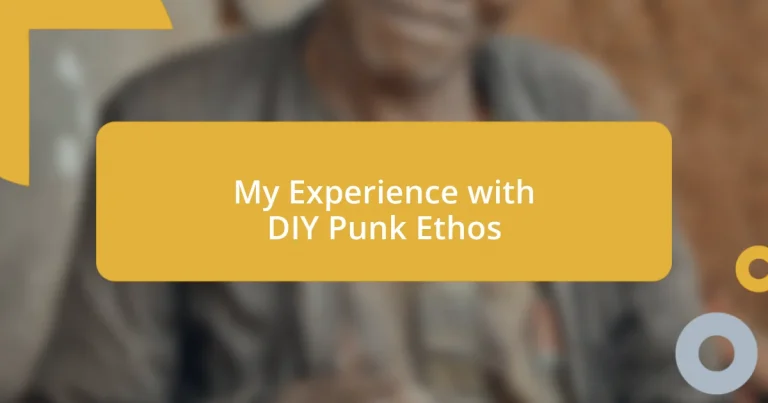Key takeaways:
- The DIY punk ethos emphasizes self-sufficiency, creativity, and authenticity, encouraging individuals to create and express themselves without relying on commercial influences.
- Key moments of personal transformation include discovering the joy of homemade merchandise at a punk show, creating art from discarded materials, and learning resilience through failures in DIY projects.
- Building a community around DIY fosters collaboration, shared experiences, and support, enhancing personal creativity and deepening connections among like-minded individuals.
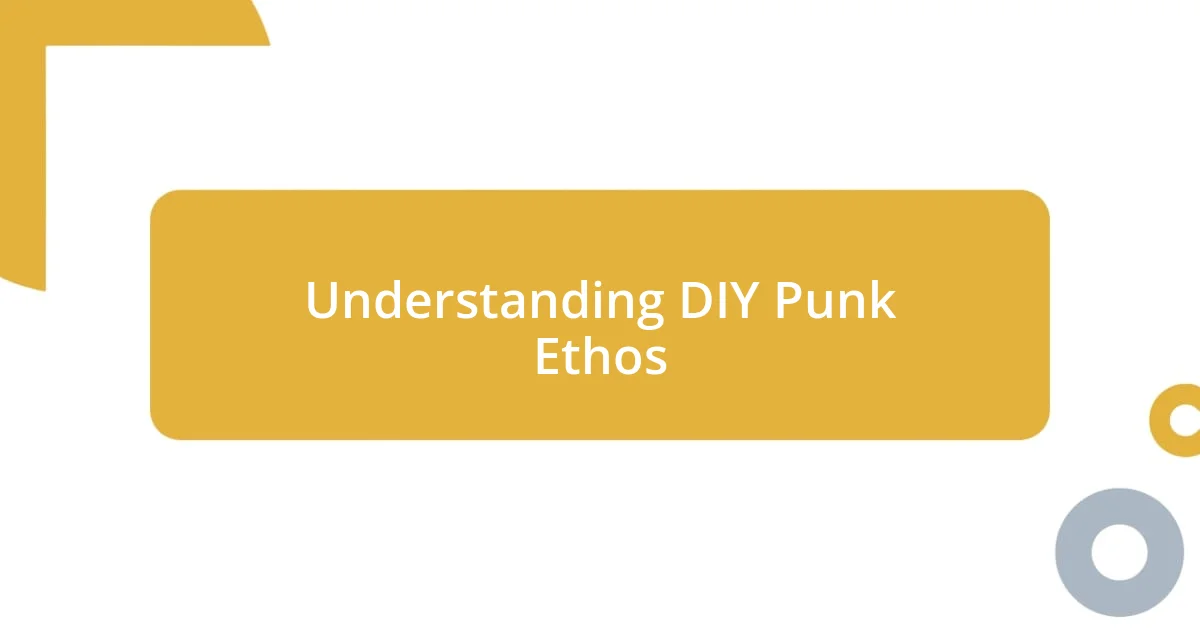
Understanding DIY Punk Ethos
At its core, the DIY punk ethos champions self-sufficiency and creativity. I remember the first time I decided to design my own band t-shirt instead of purchasing one. I felt an exhilarating mix of empowerment and rebellion—like I was not just a fan but an active participant in the culture. Have you ever experienced that rush of creating something unique that speaks to who you are?
This ethos goes beyond music; it permeates art, fashion, and lifestyle choices. Every time I see a homemade zine or a local art show featuring undiscovered talent, I’m reminded of the vibrant community that emerges when people embrace the idea of doing it themselves. Doesn’t it feel good to know that you can express yourself authentically without needing to rely on commercial influence?
The spirit of DIY punk urges us to question the status quo. For example, when I built my own speaker system instead of buying a pricey brand name, I not only saved money; I felt a deep sense of pride in crafting something functional and personal. It sparks the question: what can we create in our own lives that reflects our individuality rather than conforming to external expectations?
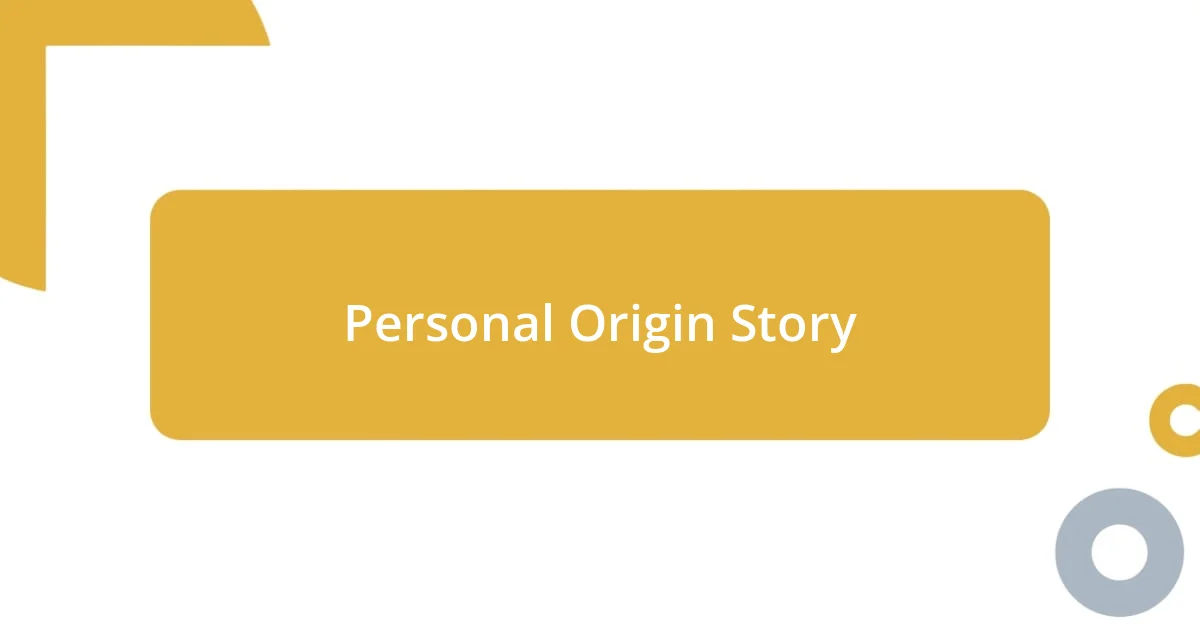
Personal Origin Story
When I think back to my early days, I can pinpoint the moment my journey into the DIY punk ethos began. It was during my high school years when I stumbled upon a local punk rock show in a dingy basement. The band played with such raw energy, and what struck me most was their homemade merch. That night, I realized that authenticity didn’t come from buying into commercial labels but from a creative spirit. It was liberating to know I didn’t have to follow the crowd; I could forge my own path.
As I delved further into the DIY culture, I found myself using what I had around the house to create my own art. One time, I transformed discarded materials into a unique piece of decor for my room. It wasn’t about perfection; it was about the process, the satisfaction of making something that was entirely my own. Have you ever felt that surge of joy from turning something ordinary into something beautiful? That feeling is at the heart of the DIY ethos.
Reflecting on my journey, I caught myself learning from countless mistakes, which ultimately shaped my creative voice. I remember messing up a simple sewing project that ended up being a jumbled mess, but rather than feeling defeated, it sparked a desire to try again and experiment with different techniques. This sense of resilience and growth was invaluable to me, teaching me that every failure is just another stepping stone toward mastery.
| Moment | Emotion |
|---|---|
| Local Punk Rock Show | Exhilaration |
| Creating Art from Discarded Materials | Joy |
| Learning from Mistakes | Resilience |
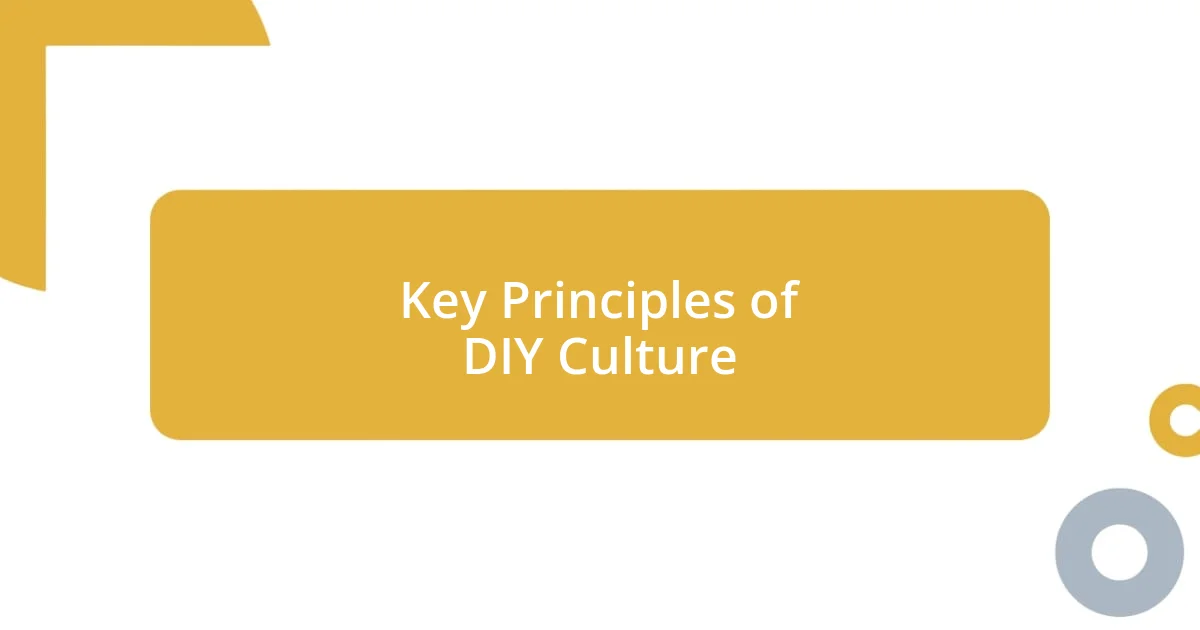
Key Principles of DIY Culture
The essence of DIY culture revolves around a few key principles that truly resonate with me. One vital aspect is resourcefulness—making the most out of what you have. I recall a time when I wanted to refurbish an old chair. Instead of splurging on new furniture, I used leftover paint and fabric scraps from previous projects. That chair turned into a conversation starter, reflecting my style and journey. What better way to personalize your space than to incorporate elements of your unique story?
Here are some of the essential principles of DIY culture:
- Self-Sufficiency: Embracing the idea that you can create, fix, or repurpose things without depending on commercial solutions.
- Creativity: Encouraging innovative thinking, allowing anyone to explore their artistic side without constraints.
- Community: Fostering collaboration and support among like-minded individuals, creating deeper connections through shared experiences.
- Sustainability: Prioritizing eco-friendly practices and making the most out of existing resources to minimize waste.
- Empowerment: Instilling confidence in individuals to take control of their own narratives and express themselves authentically.
I’ve also seen that the DIY ethos champions authenticity. When I organized a small punk show in my garage, the bands had their own homemade merchandise—everything from hand-painted record covers to zines they had printed at home. The energy was electric! Witnessing the way these artists put their heart and soul into what they created reminded me that it’s not about perfection but about genuine expression. That connection to something real is what I cherish most in DIY culture.
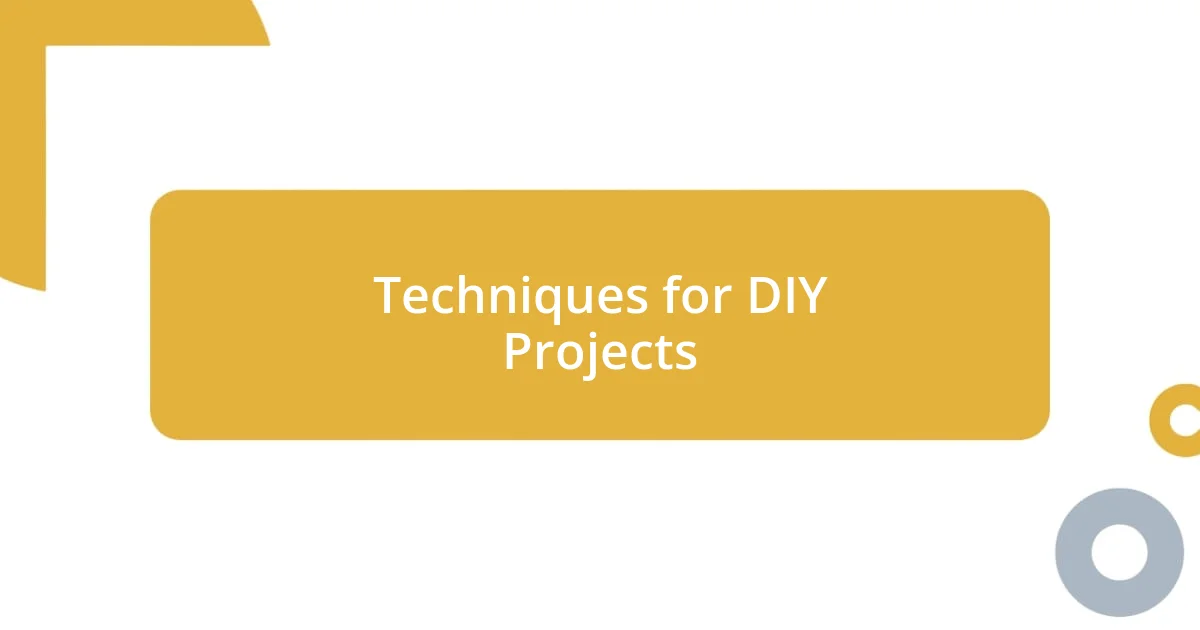
Techniques for DIY Projects
When diving into DIY projects, the techniques you use can really elevate your work. I’ve often found that utilizing what’s readily available can spark my creativity in unexpected ways. For instance, I remember rummaging through my kitchen and discovering a collection of old jars and leftover twine. I transformed them into quirky candle holders—simple, yet they added a charming touch to my space. Have you ever turned everyday items into something functional or beautiful? That kind of ingenuity is at the heart of the DIY ethos.
Experimentation is another key technique that I’ve embraced. I vividly recall trying my hand at screen printing with homemade stencils one weekend. It felt messy and chaotic, but that spontaneity led to some of my favorite designs! It’s almost thrilling to see how trial and error shapes the outcome of a project. I’ve learned to find joy in the process, even when things don’t turn out exactly as I envisioned. Isn’t it interesting how often our best creations come from those unexpected moments?
Lastly, building a community around DIY inspires not only collaboration but also skill-sharing. I often host small workshops, where friends and I gather to swap techniques and materials. It creates an energy that’s truly contagious! The laughter and learning that happens during these sessions remind me of those basement shows—everyone connecting through a shared passion for creativity. Have you ever participated in a DIY gathering? If you haven’t, I highly recommend it; the sense of belonging is as fulfilling as the creation itself!
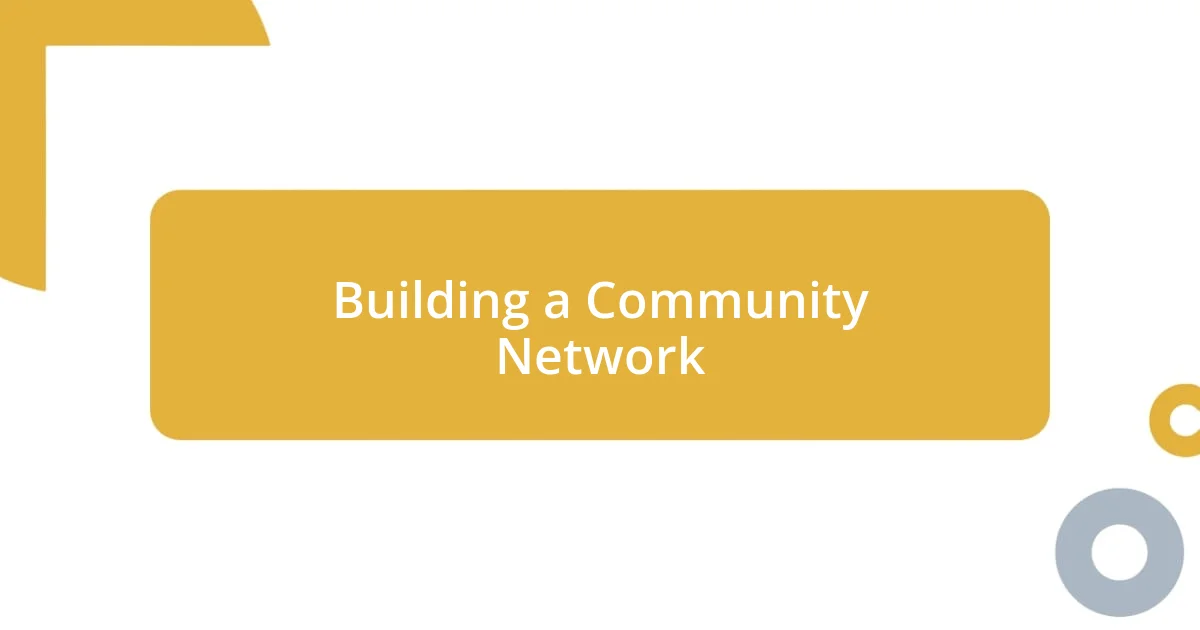
Building a Community Network
Building a community network around DIY culture is an enriching experience. I remember attending a local maker fair where I met others who shared my passion for creative projects. It was inspiring to see people of all ages collaborating, exchanging ideas, and even trading materials. Have you ever found yourself in a space where everyone’s enthusiasm fuels your own? That shared excitement can spark new friendships and collaborative endeavors that last long after the fair ends.
One of my favorite memories comes from a community garden project I was involved in. We weren’t just planting veggies; we were building connections. Each weekend, we gathered to learn from each other, swapping seeds, tips, and stories. The laughter shared over gardening mishaps created a bond that felt almost familial. It made me realize that through these shared experiences, we were not only cultivating plants but also friendships that nourished our spirits.
Then, there’s the power of online platforms in fostering community. I’ve found incredible support through social media groups dedicated to DIY projects. It’s amazing how a simple post asking for advice can lead to a flood of responses from kind strangers offering their expertise. It’s a reminder that even in the vastness of the internet, people come together to support each other’s journeys. How often do we underestimate the strength of our networks, both local and global? Those connections can truly amplify our DIY efforts and inspire us to push boundaries.

Sharing Your DIY Journey
Sharing your DIY journey can be one of the most rewarding aspects of the process. I once posted a photo of a reclaimed wood project on my social media, and the response was overwhelming. Friends and even some acquaintances began sharing their own creations in the comments, creating a thread of inspiration and creativity that brought us closer together. Have you ever experienced that rush of connection when someone appreciates your work? It’s this beautiful circle of encouragement that fuels our passion.
I find that storytelling is a vital part of sharing my DIY experiences. I remember detailing the story behind a funky tie-dye t-shirt I made during a rainy weekend. Not only did my friends enjoy the visual, but they also loved hearing about the mishaps—like the dye splattering more than I had anticipated! Sharing these genuine moments creates a sense of authenticity that resonates with others. Isn’t it incredible how a simple shirt can spark laughter and camaraderie?
Sometimes sharing goes beyond just the tangible projects. I often write blog posts where I reflect on the emotional journey behind my DIY endeavors, exploring themes like perseverance, joy, and even frustration. I feel it’s essential to capture not just how something was made, but the feelings tied to each project. Have you ever shared something personal about your creative journey? I can tell you firsthand, opening up about the highs and lows fosters a deeper connection with those who read your story and encourages them to reflect on their own paths.

Lessons Learned and Future Goals
Reflecting on my DIY journey, one key lesson I’ve learned is the importance of embracing failures. I vividly remember a sewing project that didn’t turn out as I envisioned. The fabric I chose clashed spectacularly with my initial idea, and I almost tossed it aside in frustration. But instead, I decided to transform my blunder into something new. It taught me that sometimes, our mistakes can lead to unexpected creativity. Have you ever found that a misstep opened new doors for you?
As I look ahead, my goal is to deepen my knowledge of sustainable materials. I took a workshop on upcycling recently, which was an eye-opener. I hadn’t realized how many resources were available to reduce waste while crafting. It sparked the idea of creating a series of DIY guides focused solely on eco-friendly projects. Isn’t it exciting to think about how these guides could inspire others to rethink their craft choices?
Moreover, I want to cultivate deeper community connections through collaboration. I’ve been eyeing local art co-ops where people can share tools, resources, and skills. I envision organizing monthly DIY meetups, where we gather not only to create but to learn from each other’s unique approaches. How wonderful would it be to see a diverse group come together, each person contributing their special flair? I anticipate that these gatherings will be just as much about the community as they are about crafting.












